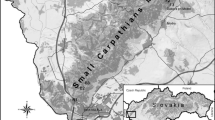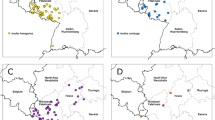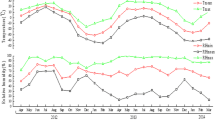Abstract
Questing ticks were collected during monthly dragging sessions (March–August 2011) in three provinces of the Liguria region, north-western Italy, to evaluate the species occurrence, spatial distribution and relative abundance. A total of 1,464 specimens were collected in 94 dragging sites. Ixodes ricinus was the most abundant species (81.3 % of collected ticks), followed by Haemaphysalis punctata (10.9 %), Dermacentor marginatus (5.5 %), Ixodes frontalis (1.3 %), and Rhipicephalus spp. (0.9 %). Ixodes frontalis is reported for the first time in Liguria. An aggregation of I. ricinus positive sites was observed in inland areas characterized by dense forests dominated by deciduous trees (Castanetum and Fagetum phytoclimatic zones), especially in the west of the region where the differences in the Normalized Difference Vegetation Index (NDVI) were higher between inland and coastal sites. Negative binomial regression for repeated measures was used to model the associations of NDVI and season with counts of host-seeking I. ricinus nymphs. The NDVI was a good predictor of I. ricinus nymphs abundance, and confirmed its utility in discriminating habitat suitability for this vector in north-western coastal Italy, where dry habitat conditions may limit the distribution of this species.



Similar content being viewed by others
References
Bivand R et al (2013) spdep: Spatial dependence: weighting schemes, statistics and models. R package version 0.5-56. http://CRAN.R-project.org/package=spdep
Bertolotti L, Tomassone L, Tramuta C, Grego E, Amore G, Ambrogi C, Nebbia P, Mannelli A (2006) Borrelia lusitaniae and spotted fever group rickettsiae in Ixodes ricinus (Acari: Ixodidae) in Tuscany, central Italy. J Med Entomol 43:159–165
Beugnet F, Marié JL (2009) Emerging arthropod-borne diseases of companion animals in Europe. Vet Parasitol 163:298–305
Bisanzio D, Amore G, Ragagli C, Tomassone L, Bertolotti L, Mannelli A (2008) Temporal variations in the usefulness of normalized difference vegetation index as a predictor for Ixodes ricinus (Acari: Ixodidae) in a Borrelia lusitaniae focus in Tuscany, central Italy. J Med Entomol 45:547–555
Braun-Blanquet J (1979) Fitosociología. Bases para el estudio de las comunidades vegetales. Blume Ediciones, Madrid, p 820
Carnevali L, Pedrotti L, Riga F, Toso S (2009) Banca Dati Ungulati: status, distribuzione, consistenza, gestione e prelievo venatorio delle popolazioni di Ungulati in Italia. Rapporto 2001–2005. Biol Cons Fauna 117:1–168 [Italian-English text]
Ciceroni L, Ciarrocchi S (1998) Lyme disease in Italy, 1983–1996. New Microbiol 21:407–418
Cimmino MA, Fumarola D, Sambri V, Accardo S (1992) The epidemiology of Lyme borreliosis in Italy. Microbiologica 15:419–424
Cliff AD, Ord JK (1981) Spatial processes: models and applications. Pion, London, p 266
Cringoli G, Iori A, Rinaldi L, Veneziano V, Genchi C (2005) Zecche. Mappe Parassitologiche. Rolando, Napoli
Crovato F, Nazzari G, Fumarola D, Rovetta G, Cimmino MA, Bianchi G (1985) Lyme disease in Italy: first reported case. Ann Rheum Dis 44:570–571
Daniel M, Dusbábek F (1994) Micrometeorological and microhabitat factors affecting maintenance and dissemination of tick-borne disease in the environment. In: Sonenshine DE, Mather TN (eds) Ecological dynamics of tick-borne zoonoses, 1st edn. Oxford University Press, New York, pp 91–138
Dantas-Torres F, Otranto D (2013) Species diversity and abundance of ticks in three habitats in southern Italy. Ticks Tick Borne Dis 4:251–255
Dautel H, Dippel C, Oehme R, Hartelt K, Schettler E (2006) Evidence for an increased geographical distribution of Dermacentor reticulatus in Germany and detection of Rickettsia sp. RpA4. Int J Med Microbiol 296(Suppl. 40):149–156
Durio P, Durante G, Sobrero L (1983) Contributo alla conoscenza della fauna ixodologica italiana. Indagini sulla distribuzione della zecche del Piemonte e della Liguria. Riv Parassitol 43:345–352
Estrada-Peña A (1999) Geostatistics as predictive tools to estimate Ixodes ricinus (Acari: Ixodidae) habitat suitability in the Western Palearctic from AVHRR satellite imagery. Exp App Acarol 23:337–349
Estrada-Peña A, Bouattour A, Camicas JL, Walker AR (2004) Ticks of domestic animals in the Mediterranean Region. A guide to identification of species, 1st edn. University of ZaragozaPress, Zaragoza, pp 131
Estrada-Peña A, Venzal JM, Sánchez Acedo C (2006) The tick Ixodes ricinus: distribution and climate preferences in the western Palaearctic. Med Vet Entomol 20:189–197
Estrada-Peña A, Gray JS, Kahl O, Lane RS, Nijhof AM (2013a) Research on the ecology of ticks and tick-borne pathogens-methodological principles and caveats. Front Cell Infect Microbiol 3:29
Estrada-Peña A, Farkas R, Jaenson TG, Koenen F, Madder M, Pascucci I, Salman M, Tarrés-Call J, Jongejan F (2013b) Association of environmental traits with the geographic ranges of ticks (Acari: Ixodidae) of medical and veterinary importance in the western Palearctic. A digital data set. Exp Appl Acarol 59:351–366
Giraudoux P (2013) pgirmess: Data analysis in ecology. R package version 1.5.7. http://CRAN.R-project.org/package=pgirmess
Gray JS, Dautel H, Estrada- Peña A, Kahl O, Lindgren E (2009) Effects of climate change on ticks and tick-borne diseases in Europe. Interdiscip Perspect Infect Dis ID 593232
Gray J, Dantas-Torres F, Estrada-Peña A, Levin M (2013) Systematics and ecology of the brown dog tick, Rhipicephalus sanguineus. Ticks Tick Borne Dis 4:171–180
Jaenson TG, Eisen L, Comstedt P, Mejlon HA, Lindgren E, Bergström S, Olsen B (2009) Risk indicators for the tick Ixodes ricinus and Borrelia burgdorferi sensu lato in Sweden. Med Vet Entomol 23:226–237
Kiewra D, Czulowska A (2013) Evidence for an increased distribution range of Dermacentor reticulatus in south-west Poland. Exp Appl Acarol 59:501–506
Kitron U (1998) Landscape ecology and epidemiology of vector-borne diseases: tools for spatial analysis. J Med Entomol 35:435–445
Littel RC, Stroup WW, Freund RJ (2002) SAS® for linear models, 4th edn. SAS Institute Inc., Cary, p 466
Manfredi MT, Dini V, Piacenza S, Genchi C (1999) Tick species parasitizing people in an area endemic for tick-borne diseases in north-western Italy. Parassitologia 41:555–560
Manilla G (1998) Acari, Ixodida (Fauna d’Italia 36). Italy, Edizioni Calderoni, p 280
Mannelli A, Tolari F, Pedri P, Stefanelli S (1997) Spatial distribution and seasonality of ticks (Acarina: Ixodidae) in a protected area in the northern Apennines. Parassitologia 39:41–45
Mannelli A, Cerri D, Buffrini L, Rossi S, Rosati S, Arata T, Innocenti M, Grignolo MC, Bianchi G, Iori A, Tolari F (1999) Low risk of Lyme borreliosis in a protected area on the Tyrrhenian coast, in central Italy. Eur J Epidemiol 15:371–377
Mannelli A, Boggiatto G, Grego E, Cinco M, Murgia R, Stefanelli S, De Meneghi D, Rosati S (2003) Acarological risk of exposure to agents of tick-borne zoonoses in the first recognized Italian focus of Lyme borreliosis. Epidemiol Infect 131:1139–1147
Medlock JM, Hansford KM, Bormane A et al (2013) Driving forces for changes in geographical distribution of Ixodes ricinus ticks in Europe. Parasit Vectors 6:1
Molenberghs G, Verbeke G (2005) Models for discrete longitudinal data. Springer, New York, p 683
Movila A, Alekseev AN, Dubinina HV, Toderas I (2013) Detection of tick-borne pathogens in ticks from migratory birds in the Baltic region of Russia. Med Vet Entomol 27:113–117
Parola P, Paddock CD, Raoult D (2005) Tick-borne rickettsioses around the world: emerging diseases challenging old concepts. Clin Microbiol Rev 18:719–756
Parola P, Rovery C, Rolain JM, Brouqui P, Davoust B, Raoult D (2009) Rickettsia slovaca and R. raoultii in tick-bornerickettsioses. Emerg Infect Dis 15:1105–1108
Pavari A (1916) Parte generale. In: Ricci M (ed) Studio preliminare sulla coltura di specie forestali esotiche in Italia. Annali del Regio Istituto Superiore Nazionale Forestale, Firenze, vol I (1914–1915), p 221
Pedemonte R (2004) Contributo alla classificazione dei climi della Liguria. 6- Distribuzione geografica delle precipitazioni annue I parte. Rivista Ligure di Meteorologia 11. http://www.nimbus.it/liguria/rlm11/clima_liguria.htm). Accessed Oct 2013
R Core Team (2013) R: A language and environment for statistical computing. R Foundation for Statistical Computing, Vienna, Austria. URL:http://www.R-project.org
Raganella-Pelliccioni E, Riga F, Toso S (2013) Linee guida per la gestione degli Ungulati. Cervidi e Bovidi. ISPRA (Istituto Superiore per la Protezione e la Ricerca Ambientale). http://www.isprambiente.gov.it/it/pubblicazioni/manuali-e-linee-guida/linee-guida-per-la-gestione-degli-ungulati.-cervidi-e-bovidi. Accessed Oct 2013
Randolph SE, Storey K (1999) Impact of microclimate on immature tick-rodent host interactions (Acari: Ixodidae): implications for parasite transmission. J Med Entomol 36:741–748
Randolph SE, Anda P, Avsic-Zupanc T et al (2010) Human activities predominate in determining changing incidence of tick-borne encephalitis in Europe. Euro Surveill 15(27):24–31
Rizzoli A, Merler S, Furlanello C, Genchi C (2002) Geographical information systems and bootstrap aggregation (bagging) of tree-based classifiers for Lyme disease risk prediction in Trentino, Italian Alps. J Med Entomol 39:485–492
Rizzoli A, Hauffe H, Carpi G, Vourc H G, Neteler M, Rosà R (2011) Lyme borreliosis in Europe. Euro Surveill 16(27):19906
Schorn S, Schöl H, Pfister K, Silaghi C (2011) First record of Ixodes frontalis collected by flagging in Germany. Ticks Tick Borne Dis 2:228–230
Selmi M, Martello E, Bertolotti L, Bisanzio D, Tomassone L (2009) Rickettsia slovaca and Rickettsia raoultii in Dermacentor marginatus ticks collected on wild boars in Tuscany, Italy. J Med Entomol 46:1490–1493
Tagliapietra V, Rosà R, Arnoldi D, Cagnacci F, Capelli G, Montarsi F, Hauffe HC, Rizzoli A (2011) Saturation deficit and deer density affect questing activity and local abundance of Ixodes ricinus (Acari, Ixodidae) in Italy. Vet Parasitol 183:114–124
Vorou RM, Papavassiliou VG, Tsiodras S (2007) Emerging zoonoses and vector-borne infections affecting humans in Europe. Epidemiol Infect 135:1231–1247
Zahler M, Filippova NA, Morel PC, Gothe R, Rinder H (1997) Relationships between species of the Rhipicephalus sanguineus group: a molecular approach. J Parasitol 83:302–306
Acknowledgments
The authors thank all personnel of Experimental Zooprophylactic Institute of Piedmont, Liguria and Aosta Valley, and University of Turin, directly or indirectly involved in this work, and especially those who helped us in the fieldwork: Debora Corbellini, Saverio Bessone and Elisa Martello. This study was supported by the Istituto Zooprofilattico Sperimentale di Piemonte, Liguria e Valle d’Aosta depending from the Ministry of Health, Italy (IZSPLV 02/09 RC).
Author information
Authors and Affiliations
Corresponding author
Electronic supplementary material
Below is the link to the electronic supplementary material.
Rights and permissions
About this article
Cite this article
Ceballos, L.A., Pintore, M.D., Tomassone, L. et al. Habitat and occurrence of ixodid ticks in the Liguria region, northwest Italy. Exp Appl Acarol 64, 121–135 (2014). https://doi.org/10.1007/s10493-014-9794-y
Received:
Accepted:
Published:
Issue Date:
DOI: https://doi.org/10.1007/s10493-014-9794-y




